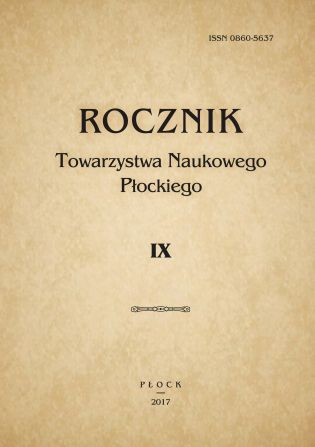Pożary i walka z ogniem w średniowieczu / Fires and fighting against them in Medieval Times
Abstrakt
Streszczenie: Ogień od najdawniejszych czasów uważany był za wielki, nieokiełznany żywioł. Rozwój cywilizacyjny ludzkości na przestrzeni wieków, a przede wszystkim powstanie nowych dziedzin wytwórczych, uniezależnienie się od warunków klimatycznych oraz stopniowe opanowywanie sił przyrody przyczyniały się do podporządkowania ognia woli człowieka. Dla współczesnego człowieka ogień jest zjawiskiem oczywistym oraz powszechnie i codziennie używanym. Umiejętność wzniecania ognia na potrzeby człowieka nie była i nie jest równoznaczna z umiejętnością obrony w przypadku przeistoczenia się ognia w pożar.
Okres średniowiecza w Polsce, przypadający od X do połowy XVI w., obfitował w zdarzenia, w czasie których ognia używano jako strategicznej broni lub do obrony warowni, grodów, zamków i siedzib książąt. Istotnymi metodami ich zdobywania było podpalanie oraz stosowanie płonących strzał wyrzucanych przez machiny miotające. Liczne i częste w dawnych wiekach wybuchające pożary, powodowane działaniami wojennymi, szczególnie dotkliwie odbijały się na życiu mieszkańców, którzy swój byt opierali przede wszystkim na rzemiośle i handlu. Zrujnowany dobytek mieszczan oraz zniszczona infrastruktura z reguły doprowadzały do upadku miasto czy zamek.
Oprócz pożarów związanych z działaniami wojennymi równie często wybuchały one na skutek nieostrożności ludzi, przynosząc straty w majątku ruchomym i nieruchomym, w rolnictwie, rzemiośle oraz handlu.
Zapobiegliwi właściciele miast polskich, w kontekście często wybuchających pożarów zaczęli dostrzegać konieczność uporządkowanej ochrony oraz obrony przeciwpożarowej i wprowadzili odpowiednie przepisy oraz postanowienia. Szczególny nacisk kładziono na pomoc ze strony sąsiadów i najbliższych oraz doceniano finansowania zakupu sprzętu do gaszenia pożarów przez władze miast. Gaszące nimi pożar mieszczaństwo, a na wsiach pospólstwo, posługiwało się wyposażeniem, jakie posiadali w codziennym użytku.
Dojrzewająca myśl utworzenia skutecznego frontu obrony przed pożarami przez przeszkolone i wyposażone w sprzęt oddziały pożarnicze ziściła się na terenie ziem polskich dopiero w połowie XIX w. Te najstarsze w naszym kraju organizacje społeczne przeznaczone do walki z pożarami rozpoczęły swą działalność w okresie zaborów. Nie ulega wątpliwości, że odegrały one ważną rolę, nie tylko skutecznie walcząc z plagą pożarów, ale spełniały także wiele innych funkcji w życiu społeczeństwa.
Słowa kluczowe: ogień, średniowiecze, miasto, zamek, straty, podpalenie, przepisy przeciwpożarowe, ochrona przeciwpożarowa, straż pożarna.
Summary: The fire from the earliest times was always considered as a great, unstoppable force of nature. The civilization development of mankind that was taking place over the centuries, as well as the technological progress, slowly allowed us to gain certain level of control over climate conditions and nature forces. For modern man fire is an obvious phenomenon and is nothing unusual. Obviously, the ability to set and use fire for human needs and have it under control was not, and is not, equal to the ability of defending against it in the event of losing control over it.
The medieval period in Poland, dating from the tenth to the middle of the sixteenth century, abounded in the events during which fire was used as a strategic weapon or to defend fortresses, castles, cities and other properties. The important methods of conquering them were by burning and using burning arrows thrown by the propelling machines. Numerous and frequent fires caused by the military activities were the most common events having a negative impact and affecting the lives of the inhabitants, who were primarily making their living from crafts and trade. The ruined burghers' possessions and destroyed infrastructure usually led to the fall of the castles and cities.
In addition to the fires associated with warfare, they often exploded as a consequence of the carelessness of the people, resulting in losses in properties, agriculture, crafts and commerce.
Preventive owners of Polish cities, in the context of frequent fires, began to see the need for protection against it and started to introduce appropriate provisioning steps and regulations. Particular emphasis was put on the help of neighbors and living nearby inhabitants, as well as efforts related to financing and purchasing of firefighting equipment by city authorities. Ali these and other available tools were then used by city and village inhabitants to fight against fire.
The maturing idea of creating an effective fire prevention front by trained and equipped firefighting units was not realized in the Polish lands until the middle of the 19th century. The oldest fire societies in our country started their activities only during the Partitions period. There is no doubt that they have played an important role, not only in fighting fires but also in many other aspects of the society.
Keywords: fire, medieval, city, castle, losses, arson, fire regulations, fire protection, fire brigade.
